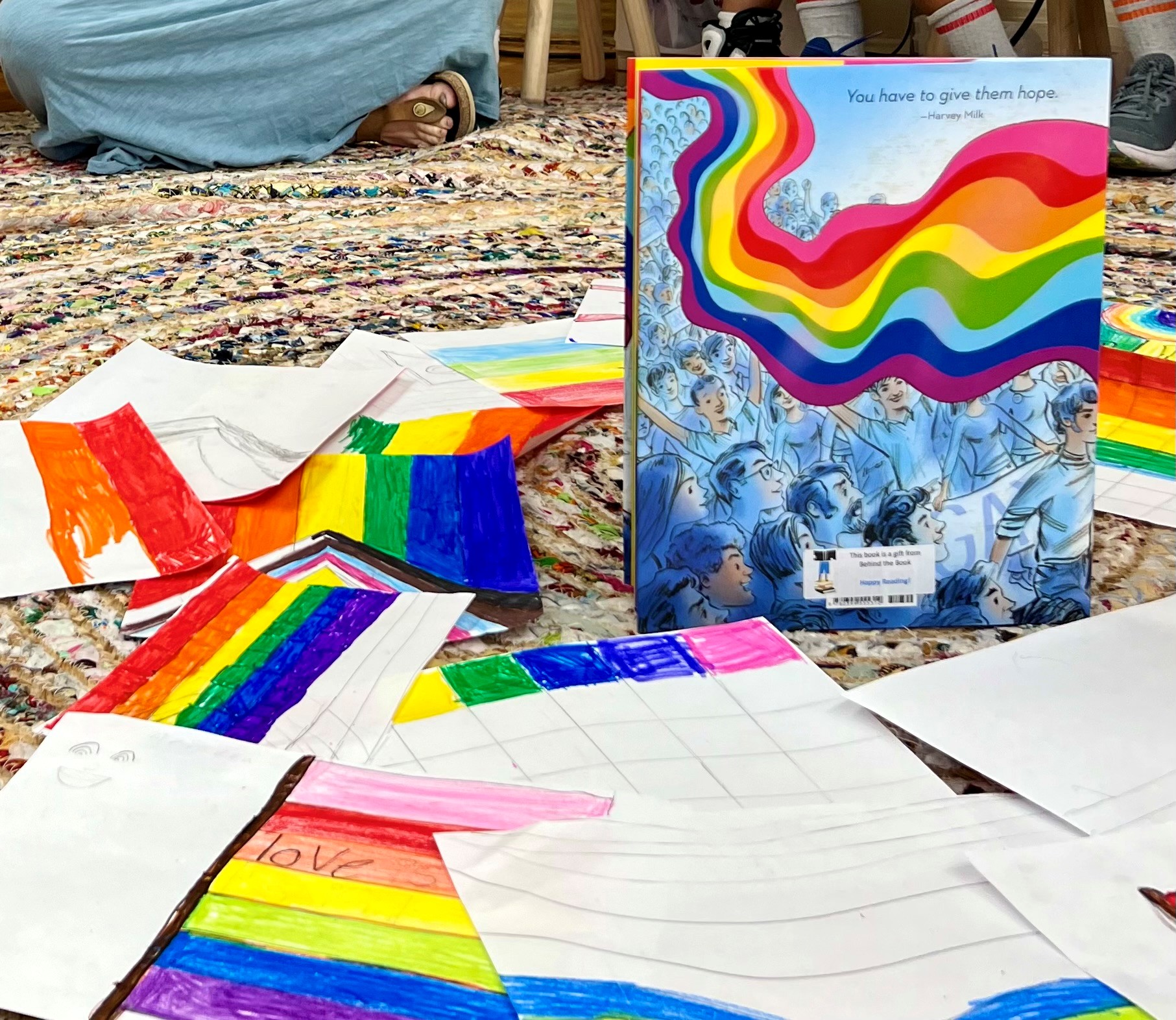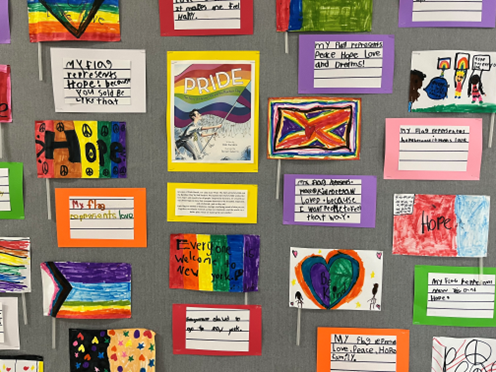A First Grade Circle for Pride Month
In first grade, Ms. Sera used the book Pride: The Story of Harvey Milk and the Rainbow Flag by Rob Sanders and illustrated by Steven Salerno, to introduce Pride Month to her students this year.
In first grade, Ms. Sera used the book Pride: The Story of Harvey Milk and the Rainbow Flag by Rob Sanders and illustrated by Steven Salerno, to introduce Pride Month to her students this year.
In first grade, Ms. Sera used the book Pride: The Story of Harvey Milk and the Rainbow Flag by Rob Sanders and illustrated by Steven Salerno, to introduce Pride Month to her students this year.
Ms. Sera started her lesson by showing an original version of the pride flag to her students and then the current version with the additional colors. She asked her students if they knew this flag and what it represented. She also asked them if they’d seen it before. Students shared that they’d seen it in their doctor’s office and in coffee shops in their communities. They were able to connect with it and Ms. Sera explained that the flag is meant to convey acceptance and to make you feel safe.
 Next Ms. Sera showed her students the book, which tells the story of gay rights activist Harvey Milk and how the pride flag was conceived. Ms. Sera read from the book that Harvey had an idea. As “his friends planned marches to protest inequality and unfair laws…. he thought, ‘we need a symbol that shows who we are and how we feel. Something to carry during the March. Something to make people feel they're part of a community. Something to give people hope. Something extraordinary.’” Ms. Sera and her students learned about Gilbert Baker who designed “a flag with eight colorful stripes, a flag that Harvey hoped would give hope,” that one day there would be equality and that “people would be able to live and love as they pleased.” Students explored what the colors of the flag stood for and, with Juneteenth coming up, they discussed what freedom looks like, making connections to the times we are living in.
Next Ms. Sera showed her students the book, which tells the story of gay rights activist Harvey Milk and how the pride flag was conceived. Ms. Sera read from the book that Harvey had an idea. As “his friends planned marches to protest inequality and unfair laws…. he thought, ‘we need a symbol that shows who we are and how we feel. Something to carry during the March. Something to make people feel they're part of a community. Something to give people hope. Something extraordinary.’” Ms. Sera and her students learned about Gilbert Baker who designed “a flag with eight colorful stripes, a flag that Harvey hoped would give hope,” that one day there would be equality and that “people would be able to live and love as they pleased.” Students explored what the colors of the flag stood for and, with Juneteenth coming up, they discussed what freedom looks like, making connections to the times we are living in.
As she wrapped up the read-aloud about this flag as a “symbol of love and equality for millions of people around the world,” Ms. Sera invited her students to create their own flag—a flag that represents acceptance for them.
 Students went back to their seats to design and draw their own personalized flags before returning to a circle on the rug where they were invited to show their flag and talk about what it stands for. As the talking piece went around one student shared that their flag represented “New York, and New York accepts everybody.” Another student doubled down on that with a flag that stated, “Everyone welcome to New York.” For other students still, their flags represented “hope because it means love” and “my flag represents love, peace, hope and family.”
Students went back to their seats to design and draw their own personalized flags before returning to a circle on the rug where they were invited to show their flag and talk about what it stands for. As the talking piece went around one student shared that their flag represented “New York, and New York accepts everybody.” Another student doubled down on that with a flag that stated, “Everyone welcome to New York.” For other students still, their flags represented “hope because it means love” and “my flag represents love, peace, hope and family.”
Like the other teachers at her school, Ms. Sera, and her co-teacher Ms. Mandy, have been teaching about social movements all year. Besides academics, these first graders learned about the communities they are a part of and how to build a kind, supportive and equitable classroom community that welcomes everyone—the kind of pro-active restorative community needed for responsive restorative practices to take hold and resonate with staff and students alike.
Theirs is the kind of classroom Milk envisioned where “all young people, regardless of...identity, deserve a safe and supportive environment in which to achieve their full potential.” As the school year comes to a close, one of the first graders captured Milk’s dream in that June circle as they shared: “my flag represents peace, kindness and love because I want people to feel that way.”